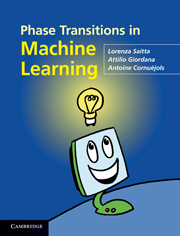Book contents
- Frontmatter
- Contents
- Preface
- Acknowledgments
- Notation
- 1 Introduction
- 2 Statistical physics and phase transitions
- 3 The satisfiability problem
- 4 Constraint satisfaction problems
- 5 Machine learning
- 6 Searching the hypothesis space
- 7 Statistical physics and machine learning
- 8 Learning, SAT, and CSP
- 9 Phase transition in FOL covering test
- 10 Phase transitions and relational learning
- 11 Phase transitions in grammatical inference
- 12 Phase transitions in complex systems
- 13 Phase transitions in natural systems
- 14 Discussion and open issues
- Appendix A Phase transitions detected in two real cases
- Appendix B An intriguing idea
- References
- Index
12 - Phase transitions in complex systems
Published online by Cambridge University Press: 05 August 2012
- Frontmatter
- Contents
- Preface
- Acknowledgments
- Notation
- 1 Introduction
- 2 Statistical physics and phase transitions
- 3 The satisfiability problem
- 4 Constraint satisfaction problems
- 5 Machine learning
- 6 Searching the hypothesis space
- 7 Statistical physics and machine learning
- 8 Learning, SAT, and CSP
- 9 Phase transition in FOL covering test
- 10 Phase transitions and relational learning
- 11 Phase transitions in grammatical inference
- 12 Phase transitions in complex systems
- 13 Phase transitions in natural systems
- 14 Discussion and open issues
- Appendix A Phase transitions detected in two real cases
- Appendix B An intriguing idea
- References
- Index
Summary
Even though this book is focused on learning, we thought it might be useful to widen its scope to include a brief overview of the emergence of ensemble phenomena (typically phase transitions) in complex networks. Beside their intrinsic interest as systems amenable to be studied via statistical physics methods, complex networks may well impact relational learning because both examples and formulas can be represented as networks of tuples, as we have seen in previous chapters. The same can be said for the constraint graph in CSP and the factor graph in SAT. In ensemble phenomena, emerging from a network of “microscopic” interactions, it is likely that the underlying graph structure has an impact on the observed macroscopic properties; thus cross-fertilization might be of mutual benefit.
Complex networks are complex systems, meaning systems composed of a large number of mutually interacting components. Even though in such systems it is impossible to describe the behavior of the individual components, the patterns of interactions among them allows macroscopic properties to emerge which would be missed by a reductionist approach. Thus, the science of complexity aims to discover the nature of these emerging behaviors and to link them to the system's microscopic level description.
Complex systems
From its very definition, it is clear that the science of complexity naturally derives from statistical physics. Thus, the emergence of phase transitions and the behavior of complex systems have strong links.
- Type
- Chapter
- Information
- Phase Transitions in Machine Learning , pp. 300 - 312Publisher: Cambridge University PressPrint publication year: 2011
- 1
- Cited by



